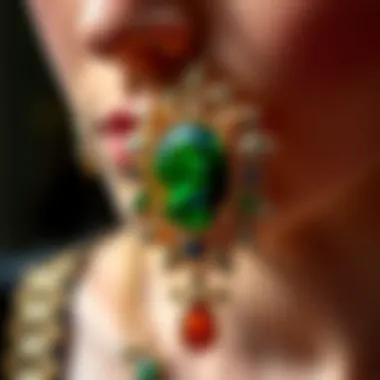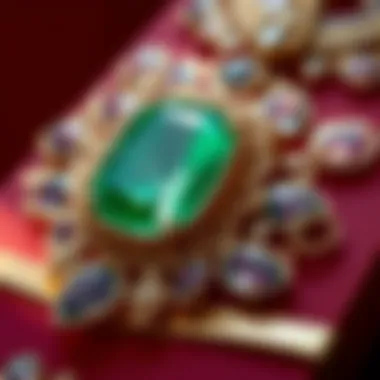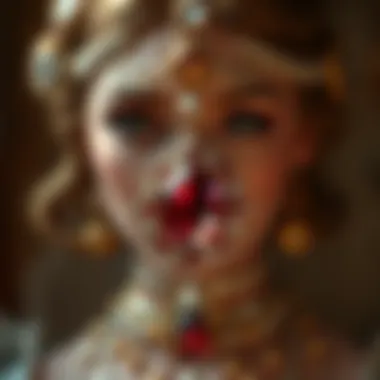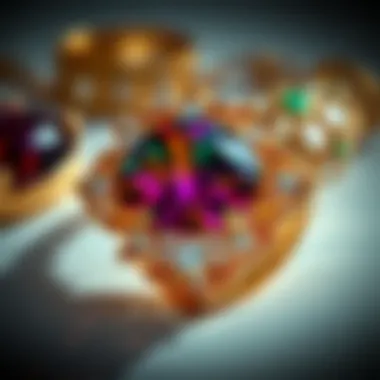Exploring the Romanov Jewels: History and Market Trends


Intro
The story of Romanov jewels is one soaked in history, opulence, and intrigue. For centuries, these sparkling treasures have represented not just beauty, but the very spirit of the Russian monarchy. As collectors and enthusiasts look to acquire these stunning pieces, it is crucial to understand the context in which they were created, the craftsmanship behind them, and their lasting significance in both history and culture.
When we speak of gemstones, we're not merely talking about shiny objects that catch the eye. We're exploring a rich heritage that blends artistry and rarity. Romanov jewels, specifically, encompass a stunning array of gemstones, every one with its own story to tell. As we embark on this exploration, it is vital to grasp the underlying elements that make these jewels more than just adornments. They are history incarnate, intricately woven into the fabric of Russia’s past.
Gemstone Overview
Definition of Gemstones
Gemstones bear an essential place in both nature and human culture. By their very definition, they are minerals or rocks cut and polished for personal decoration and adornment. It's interesting to note that not all gemstones are created equal. Some may be natural, derived directly from the earth, while others might have undergone significant alteration through synthetic processes.
Classification of Gemstones
Gemstones are typically classified into several categories:
- Precious Gemstones: The cr�ème de la crème includes diamonds, rubies, sapphires, and emeralds. These gems are prized for their rarity, durability, and stunning appearance.
- Semi-Precious Gemstones: This category consists of various stones such as amethyst, aquamarine, and garnet. While they may not carry the same price tag as precious stones, their beauty is undeniable.
- Organic Gemstones: A fascinating subset includes items like pearls and amber, which arise from biological processes rather than mineral formation.
Navigating the world of gemstones can feel like stepping into a treasure trove, where each piece not only glimmers but also holds centuries of narrative tied to the Romanovs' legacy.
Historical Significance
Origins of Gemstone Use
Historically, the allure of gemstones has transcended time and geography. The usage of these stones dates back thousands of years, with ancient cultures attributing them unique meanings and powers. In many cases, they were seen as symbols of status or used in spiritual practices, enhancing their desirability in royal circles.
Then, along came the Romanovs. This imperial family, which ruled Russia for over three centuries, embraced the use of jewels as an essential facet of their identity. The gems in their collection went beyond mere accessories; they were declarations of power, wealth, and deeply ingrained cultural values.
Cultural Insights: Gemstones in Ancient Civilizations
Across various civilizations, gemstones have held significant cultural value. For example, the Egyptians used lapis lazuli in burial rituals, believed to protect the dead in the afterlife. The Greeks saw emeralds as a symbol of fertility. Each culture celebrated different stones for their unique attributes and meanings.
Consider the Romanov fascination with diamonds and sapphires. These stones were not only a showcase of wealth but also tools for political diplomacy. By wearing opulent jewels during state functions, the Romanovs communicated messages of strength and stability. They understood that precious stones were more than beautiful; they were essential components of their power play.
"Jewels are like the history books of the earth; they tell stories about the people who possess them"
— Anonymous
As we delve deeper into the current landscape surrounding these captivating artifacts, recognizing their historical weight becomes indispensable. This exploration not only enriches understanding but also deepens appreciation for the complexities involved in acquiring such exquisite pieces today.
This insight lays the groundwork as we navigate towards current market trends, appraisals, and the ethical considerations that come with owning a piece of history.
History of the Romanov Jewels
The history of the Romanov jewels reveals not just a collection of extravagant adornments, but also a narrative interwoven with the royal family's legacy, societal transformations, and geopolitical upheaval. Understanding this history is crucial for both collectors and enthusiasts, as it sets the stage for appreciating the significance and cultural context of these exquisite artifacts. Each piece carries stories of opulence and power, reflecting the artistry and craftsmanship of its time while also serving as a window into the complex interactions of art, politics, and societal changes related to the Romanov dynasty.
The Origins of the Collection


The origins of the Romanov collection can be traced back to the early 18th century, under the reign of Peter the Great. These jewels were sourced from various parts of Europe and Asia, indicating the vast reach of Russian influence and the royal family's aspirations. The collection includes a myriad of pieces, from multifaceted diamond-studded tiaras to opulent necklaces featuring rare gemstones. Royal marriages played a pivotal role in expanding this collection, as alliances were often sealed with breathtaking gifts of jewelry. The choice of gems—like the Siberian diamonds and rich, vivid emeralds—speaks volumes about the Romanovs' preferences for rarity and beauty.
The Role of the Romanov Dynasty
At the heart of the Romanov jewels lies the dynasty itself. The family, reigning from 1613 until the early 20th century, not only amassed wealth but also authority through their collection. Each piece of jewelry was a statement of power, showcasing the magnificence of the empire and its rulers. The Romanovs used jewels in ceremonial occasions, where the significance transcended mere adornment; they were symbols of legitimacy and divine right. The jewels also served as intricate gifts among European royalty, weaving a network of political alliances and cultural exchanges. This interplay of royalty and jewels shaped much of the social fabric of the time, establishing a deep connection between art, culture, and politics in Russia.
Historical Events Impacting the Collection
The fate of the Romanov jewels was closely tied to the historical events faced by the dynasty. The 1917 Bolshevik Revolution marked a turning point; as political tides shifted, the opulence of the royal family became a target of disdain. Many pieces were seized, hidden, or lost forever, leading to a treasure trove of mysteries surrounding their current whereabouts. In the years that followed, fluctuating global political landscapes, including two World Wars, further disrupted the stability of jewel ownership. Surviving pieces became collectibles, each echoing tales of survival against adversity. Today, these jewels stand not only as artistic creations but as icons of resilience, embodying the tumultuous history that surrounded the Romanovs, providing a layered understanding of the collection that resonates with gemstone enthusiasts and collectors alike.
"Jewelry has this inherent ability to tie us back to moments in history, serving as a reminder of what was once glittering in the realms of power and prestige."
Craftsmanship of the Romanov Jewels
The jewels associated with the Romanov dynasty are more than mere adornments; they represent a legacy of artistry and craftsmanship that has persisted through centuries of history. Understanding the craftsmanship of these jewels is essential for collectors, enthusiasts, and historians, who seek not only the aesthetic beauty of the pieces but also the intricate techniques and materials that underpin their creation.
Techniques Used in Creation
The techniques utilized in the making of Romanov jewels are as varied as the pieces themselves, reflecting a blend of tradition and innovation.
- Enameling: One prominent technique is enameling, which involves fusing powdered glass to metal. This method not only adds color but also enhances durability, making the pieces both visually stunning and long-lasting.
- Filigree Work: Utilizing thin threads of gold or silver, artisans performed delicate filigree work, weaving intricate patterns that showcase their skill. This lace-like embellishment adds an element of softness and complexity to the designs.
- Beadwork: Another notable technique is beadwork, where gemstones are strung together to form necklaces or intricate patterns on brooches and other jewelry. The precision in this craft is key, as a single misplaced bead can disrupt the entire design.
Each technique is not merely functional but elevates the jewel into a work of art, demonstrating skills passed down through generations.
Materials and Stones
Craftsmanship in the Romanov jewels is also directly linked to the materials and stones selected for use. Gold and Silver were common bases, often adorned with precious gems like diamonds, emeralds, sapphires, and rubies.
- Diamonds: Valued for their clarity and brilliance, these stones were often the centerpiece of many Romanov heirlooms.
- Emeralds and Rubies: Known for their vivid colors, these gemstones were chosen not just for beauty but also for their cultural significance, often representing love and power.
- Unique Diamonds: Some pieces featured particularly rare diamonds, like the Imperial Pink Diamond, which adds immense value to the collection.
These materials were not only about luxury; they were a reflection of status and power within the realm.
Notable Artisans and Designers
Behind these exquisite jewels were notable artisans and designers, who contributed their creativity and skill. One of the most famed jewelers associated with the Romanovs was Karl Fabergé. Known for his exquisite Fabergé eggs, he brought innovation to imperial jewelry through his opulent designs and attention to detail.
Additionally, Mikhail Perkhin, an apprentice of Fabergé, assisted in creating many iconic pieces. His artistry can still be felt in the designs and techniques used in Romanov jewelry today.
"The artistry of the Romanov jewels is encapsulated in the diligent work of these master craftsmen, whose legacies echo through the elegance of each piece."
The craftsmanship of Romanov jewels is a testimony to a time of richness and grandeur, revealing not only the technical skills involved but also the cultural tapestries woven into the very fabric of these beautiful items.
Current Market Trends
The realm of Romanov jewels stands distinct in the jewelry market, reflecting not just the artistry involved but also the shifting dynamics of consumer interest and global economies. Recognizing current market trends is crucial for collectors, enthusiasts, and investors alike, as these trends can significantly influence the buying and selling processes of these luxurious items. To navigate this intricate landscape effectively, it’s essential to understand the valuation methods, auction patterns, and how global events shape the demand and price fluctuations for these historical treasures.


Valuation of Romanov Jewels
Valuing Romanov jewels can be a tricky business, where multiple factors come into play. To gauge the worth, experts typically assess several elements, including:
- Provenance: The history of ownership can add immense value. A piece once owned by Empress Maria Feodorovna carries more weight than a lesser-known item.
- Condition: The state of the jewels matters tremendously. A well-preserved piece will fetch a better price than one that shows significant signs of wear and damage.
- Craftsmanship: The skill employed in the piece's creation contributes to its valuation. Artisan details and intricate work can elevate the jewel’s worth.
- Market Demand: Simple supply and demand principles apply. If Romanov pieces become highly sought after due to cultural interest or media exposure, values can skyrocket.
With these factors in mind, prices can vary widely. At auction, a simple bracelet may sell for a few thousand dollars, while a significant tiara could command well over a million.
Auction Trends and Sales
The excitement of auctions provides a window into the evolving landscape of the Romanov jewels market. Recent years have shown a marked increase in both the frequency and the prices of auctions featuring these pieces. Some key trends in auction houses like Sotheby's and Christie’s include:
- Record Prices: Historical pieces often fetch record-breaking sums, reflecting both their rarity and the growing interest in royal collections.
- Global Participation: Auction events are increasingly attracting international bidders, highlighting a rising global appreciation for Russian heritage and its opulent artifacts.
- Online Auctions: The move to online bidding platforms has opened new avenues for potential buyers, enabling wider participation and often resulting in competitive bidding situations.
A notable recent auction saw a Romanov necklace sell for close to $400,000, underscoring the type of exciting opportunities that lie in this niche market.
Influence of Global Events
Global events, both socio-political and economic, can heavily influence the market for Romanov jewels. Various elements to consider include:
- Investor Psyche: Economic downturns can lead collectors to liquidate assets. Conversely, during stable or booming times, there can be an inclination to invest in luxury items as a status symbol or hedge against inflation.
- Cultural Recognition: Significant anniversaries or exhibitions featuring Romanov artifacts can rejuvenate interest, causing prices to rise due to a renewed focus on Russian heritage.
- Geopolitical Factors: Political climates can influence collectors' willingness to buy. For instance, sanctions on Russian individuals can sometimes lead to an increased interest in acquiring culturally significant artifacts elsewhere.
"Understanding the market's ups and downs is as essential as appreciating the beauty of the jewels themselves."
In summary, being aware of these current market trends equips potential buyers with the knowledge necessary to make informed decisions. Whether one is a seasoned collector or a newcomer, these insights paves the way for engaging with the exquisite world of Romanov jewels.
Ethical Considerations in Acquiring Romanov Jewels
When delving into the exquisite realm of Romanov jewels, it’s crucial to navigate the ethical landscape surrounding their acquisition. These pieces are not mere commodities; they are fragments of history, steeped in tales of opulence and tragedy. Understanding the ethical implications ensures that collectors and enthusiasts can appreciate these artifacts while also acknowledging their complex origins. Not only does this act foster respect for the cultural significance inherent in each jewel, but it also augments the collector’s experience by providing a more comprehensive understanding of ownership.
Provenance and Authenticity Challenges
The quest for Romanov jewels often leads to intricate maze of provenance and authenticity, where the importance cannot be overstated. Provenance refers to the documented history of a particular piece, including its origins, previous ownership, and the circumstances under which it was acquired. Many Romanov jewels changed hands numerous times during tumultuous events in history, leaving gaps in their documented pedigree.
- Verification: Buyers must engage with reputable sources that specialize in historical artifacts. Relying on expert appraisals not only helps verify authenticity but also ensures buyers are not inadvertently supporting the black market.
- Risks of Forgeries: The romantic allure surrounding these jewels has unfortunately given rise to a market flooded with forgeries. A discerning collector must remain vigilant and become familiar with the distinctive marks and characteristics of authentic Romanov pieces.
- Documentation: Collectors should seek detailed provenance records. They shouldn’t shy away from asking questions; transparency is key in the ethical purchase of any historic jewels.
Experts and reputable auction houses like Sotheby’s often provide insights into pieces they offer – this may include historical context that speaks to the authenticity of the items.
Cultural Heritage Issues
Acquiring Romanov jewels also raises significant cultural heritage issues that cannot be overlooked. These jewels are not just valuables; they represent a time and a dynasty that played a pivotal role in Russian history.
- Ownership Ethics: The Romanov dynasty's downfall was marked by societal upheaval and loss. What may seem like a beautiful piece of jewelry could carry the weight of a family history steeped in turmoil. Understanding the narrative behind each jewel cultivates a respect for the culture and history they embody.
- Restitution Discussions: There has been increasing dialogue surrounding the recovery of cultural artifacts. Some argue that many Romanov jewels rightfully belong to Russian heritage, highlighting a significant ethical dilemma. Acquiring such pieces without acknowledgment or respect for legislation can lead to controversies.
- Collectors' Responsibility: Those seeking to purchase Romanov jewels should not view themselves solely as buyers but as temporary stewards of these significant artifacts. A commitment to ethical collecting involves not just ownership but also a promise to protect and respect the historical significance of the pieces.
The conversation surrounding the ethical considerations in acquiring Romanov jewels is intricate and layered. Understanding these dimensions fosters a culture of respect for heritage while bringing a deeper appreciation for each glittering artifact.


"The jewels may sparkle, but it’s the stories behind them that truly illuminate their value."
For further reading on related cultural issues regarding artifacts, see Cultural Property Law and Cultural Heritage.
Collecting Romanov Jewels
The pursuit of collecting Romanov jewels is not merely an investment; it is a venture steeped in history, culture, and artistry. For gemstone enthusiasts, collectors, and jewelry designers alike, the romance behind these jewels adds layers of significance that elevate them beyond mere objects. Each piece carries tales of the Russian monarchy – adventures of opulence, heartbreak, and change. Yet simply having the will to gather such treasures isn't enough. It requires knowledge, expertise, and caution to navigate the fascinating yet complex landscape of Romanov jewelry.
Identifying Genuine Pieces
Identifying authentic Romanov jewels is a task that demands a keen eye and attention to detail. Unlike generic vintage jewelry, these pieces come from a very specific lineage, each with its own story. Collectors must be wary of reproductions and fakes that permeate the market. To distinguish genuine artifacts:
- Research Provenance: Understand the history and ownership of each item thoroughly. Items with documented histories often hold higher value.
- Examine Craftsmanship: Authentic Romanov jewels reflect exceptional craftsmanship. Look for intricate settings, unusual cuts, and the quality of the materials used.
- Consult Experts: Engaging with historians or appraisers well-versed in Russian royal jewelry can offer insights that the untrained eye might miss.
While new collectors may find the task daunting, embracing these strategies will make the journey rewarding. Don't rush this process. Like fine wine, knowledge improves with time.
Storage and Preservation Techniques
Once a collector has successfully acquired a genuine Romanov jewel, the next responsibility is to preserve it properly. Jewels not only symbolize wealth; they are also delicate and require thoughtful care. Here are some effective storage and preservation techniques to consider:
- Controlled Environment: Store jewels in a cool, dry place away from direct sunlight. Fluctuating temperatures and humidity can cause damage to the metals and stones.
- Use Proper Cases: Invest in high-quality display cases that offer protection from dust and potential physical damage. Anti-tarnish pouches can further safeguard silver pieces.
- Regular Cleaning: Periodically inspect and clean jewels responsibly. Use soft, lint-free cloths for gentle polishing. Products specifically designed for jewelry can also help, but ensure they are safe for the materials involved.
Implementing these practices not only maintain the jewel's condition but also uphold its historical integrity.
Networking with Other Collectors
Another critical aspect of collecting Romanov jewels is building a network with other collectors. The world of jeweled artifacts is much like a vibrant tapestry woven from diverse threads of backgrounds and interests. Shared experiences can lead to insightful exchanges about provenance, market trends, and restoration techniques. Here’s how to effectively network:
- Join Forums and Clubs: Online platforms such as specialist Facebook groups or Reddit communities can provide valuable insights. Engaging with fellow enthusiasts allows for the exchange of tips and leads on upcoming auctions or sales.
- Attend Exhibitions and Auctions: Regular attendance at exhibitions featuring Romanov artifacts can enhance your connections within the community. Plus, seeing pieces in person often yields information that photographs cannot capture.
- Collaborate on Research: Going deeper into the history of specific pieces or the craft techniques used can establish you as a knowledgeable member of the community. When all is said and done, knowledge shared is knowledge gained.
Through these connections, you can help foster a community that appreciates the beauty and heritage of Romanov jewels while ensuring their stories continue to shine.
The End and Future Perspectives
The exploration of Romanov jewels provides a multidimensional view not just of opulence, but of historical narratives and cultural identity. Understanding their legacy and ongoing market trends is vital for collectors and enthusiasts alike. The Romanov jewels are not merely pieces of jewelry; they embody stories of a bygone era, the craftsmanship of master artisans, and the intricate connections between art and heritage.
The Legacy of the Romanov Jewels
The legacy of these exquisite treasures is one steeped in historical significance. Having been worn by the prominent members of the Romanov dynasty, these jewels carry with them a sense of continuity and connection to Russia's royal past.
They represent the wealth and power of one of history's most recognized families, but also the turbulent events that led to their downfall. Each piece tells a story — from the extravagant royal balls to the silent witness of revolutionary upheaval. The unique designs and craftsmanship preserve a link to the cultural heritage of the era, serving as a reminder of the artistry that existed in times of splendor and excess.
"The jewels are more than just adornments; they are artifacts that bridge the past with the present, offering insights into the lives of those who wore them."
Enthusiasts appreciate these nuances, often seeking provenance as a form of validation. Items with solid historical backgrounds typically see better market performance and retain value more effectively over time.
Trends Likely to Shape the Market
Looking ahead, several trends are poised to shape the market for Romanov jewels.
- Increased Interest from Collectors: More collectors are entering this niche market, often motivated by a desire to own a piece of history. The allure of rarity and the tangible connection to the Romanovs can drive prices up.
- Online Auctions: With the advent of technology, online auction platforms are becoming the go-to for buying rare items. This method not only broadens the buyer pool but also enhances accessibility for all types of collectors.
- Ethical Considerations: As awareness grows regarding the history of these jewels, more collectors are looking for transparency in provenance. This shift will likely influence how pieces are valued and sold in the future.
- Global Economic Factors: Fluctuations in wealth across nations can significantly affect luxury spending. As emerging markets grow, there might be a broader audience eager to invest in high-end heirlooms.



